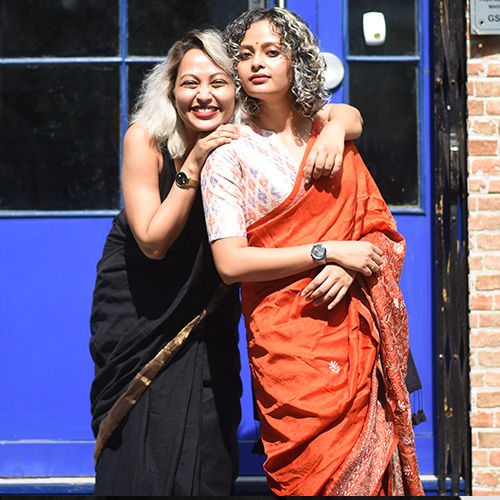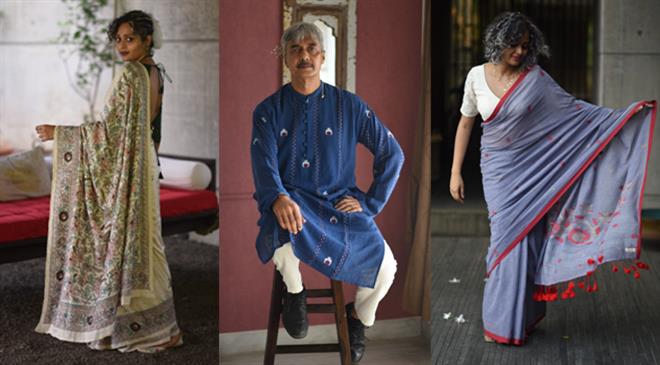
Sujata & Taniya Biswas
Founders
Suta
Our aim by 2030 is to work with at least 2 lakhs weavers
Founded by Sujata and Taniya Biswas, Suta is a humble brand which works with weavers from all over India and creates handwoven and handcrafted products. Fibre2Fashion spoke to the founders to learn about their respective backgrounds, what inspired them create the brand, and vision for the label for the upcoming years.
Fibre2Fashion: Describe yourself in one sentence?
Sujata & Taniya Biswas:
I (Sujata Biswas) am a passionately driven person and want to really work for the betterment of the society.
F2F: How would you illustrate your journey? How was your experience while launching your first collection?
S&TB:
My journey has been super as its been officially five and a half years. But it feels a lot longer because of the number of things which an entrepreneur has to do and has to go through. So, there are so many ups and downs that we have seen. It's a beautiful learning experience. And it is remarkably interesting. Because we get to work with so many people within India. And the total customer base that we have built---it's a thing that we are immensely proud of. So, we do not call our customers as customer base, but we call them community members.
F2F: Coming from an engineering background, and being sisters, how challenging was it to start a brand?
S&TB:
Engineering happened and post that MBA happened. So we had to do a lot of learning. So, I would say that everything you do in life, it has its own value, it keeps adding different layers. It is like onion, you know you keep adding personalities and layers to yourself. Since Suta is an e-commerce business, our management degree has helped us a lot. But at the same time, I will say anything you do even if it is a small two-day course, or it could be a four year engineering course--whatever you do comes handy because you know when you're running a business there are so many different verticals to deal with. Any study or anything you do, everything is useful and helps you to take a better decision or take your brand to some other level altogether with the knowledge you have gathered in your life.
F2F: Where do you find your inspiration to create such beautiful, handcrafted pieces?
S&TB:
We have been answering this question for a long time and we usually say our inspiration is nature, but nature inspires us to make designs. But our customers inspire us to make a product that is more likely to suit them. So I think each and every customer who actually takes out time to send us their photos--they inspire us to do better every time and of course the design inspiration comes from nature. Because me and Tanya--both of us love spending time in nature and nature inspires us to create what we do.
F2F: What do you admire the most about Indian fashion industry and what is your favourite weave and why?
S&TB:
The most admirable thing about Indian fashion industry is that I think it's very versatile. There is lot of space for newcomers that anybody can come in and people are very accepting about it, even fashion industry themselves.
F2F: Is there any city/state that gives you specific response for your products?
S&TB:
I think for us, the metro cities really do well. It's not a specific region, we do well in this state or in this area. It's mostly I think the kind of people we resonate with.
F2F: How do you select the materials you use?
S&TB:
We mostly go with all the instinct that we have, it's mostly inspired by the nature, as mentioned earlier. And the colours especially, it's all nature, and if you see the names and the stories behind them..you will know from where it is coming. It is mostly from the experiences of the childhood. We have lived in different states and all that comes together, and we make what we make. Also the team that we have is very young and vivacious, and they come up with all these new ideas and we sit together, discuss art all the time.
F2F: What makes your brand and product stand out from others in the same segment?
S&TB:
The reason we would say one is because of the product itself--that's the first I think.. that's what should be the differentiator apart from anything else. The second would be the community that we have built –The Suta Queens, which is a very warm, beautiful community people respecting each other and also appreciating art and culture and being this is very, very inclusive. That's what I think sets us apart is the beautiful community and our products for sure. These are the two most important things that comes to my mind.
F2F: What is your take on adoption of sarees by today’s generation?
S&TB:
This was one of our main aims when we started Suta that we will introduce sarees as regular wear and not an occasional one, especially from younger times so that you can continue wearing it. It is not that after a certain age, I would wear this attire and I can do away with all the jeans and stuff only after 30 or 35 or whatever standards that we set in our mind. We want to do away with that and hence we made all these non-fussy sarees which you can drape differently. We introduced different ways to even draping, we didn't say that you should drape it in this way or that way--we just celebrated it. So yeah, with Suta, a lot many things started and hence we are very proud to say that a lot of young people-- women and men both say that I started my journey with Suta. That's amazing to hear. 15/20 girls in a group were once wearing Suta together in the convocation of their college’s function, then that was our favourite part.
F2F: What is your vision for your label for forthcoming years? Are you planning to expand the same?
S&TB:
Our future plan is not seeing revenue numbers, but we would love to be able to work with more and more weavers. So our aim by 2030 is to work with at least two lakhs weavers. And that would mean that automatically our supply will also increase and hence the dimension. So we will work harder to make sure that we accommodate so many weavers with Suta.

Rahul Mehta
Bill D’Arienzo
Anurag Batra
Fanny Vermandel
Arun Sirdeshmukh
Abhay Gupta
Pradip Mehta
Aseem Prakash
Gabi Seligsohn
Rahul Mehta











_8.JPG)
